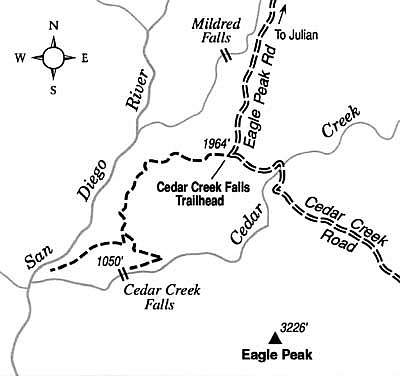 Facebook
Facebook
 X
X
 Instagram
Instagram
 TikTok
TikTok
 Youtube
Youtube
In the aftermath of this season's repeated downpours, San Diego County's "big falls" have been showing their stuff. Big, in this neck of the woods, means a hundred feet or so. Of four such falls in the upper San Diego River drainage, only one is accessible to casual hikers: Cedar Creek Falls. Another, called Mildred Falls, can be seen on the way to Cedar Creek.
Various not-quite-legal hiking routes to Cedar Creek Falls have been forged, but I will make mention of only the sole, approved route. First, drive to Pine Hills Road, which intersects Highway 78 just west of Julian, and turn south. After 1.5 miles, bear right on Eagle Peak Road. After 1.4 more miles, veer right again, staying on Eagle Peak Road. Now you face 8.2 miles of progressively poorer road, parts of which become slippery and muddy in wet weather. In the end, you come to a four-way junction of roads and a forest-service sign announcing the old road -- now a riding and hiking trail -- toward the falls. Everything within miles of here was swept over by the October 2003 Cedar Fire, but the sage and chaparral vegetation is rapidly regenerating. The current wildflower display, the best in years, will probably continue for the next several weeks.
As you head downhill, look up the canyon in the north (Ritchie Creek canyon) to see Mildred Falls, arguably San Diego County's highest at more than 100 feet. The old road winds farther west, offering a splendid view of the V-shaped upper San Diego River canyon, then turns south on a long descent to the river bed. At 1.4 miles into the hike, take the spur road that goes left (southeast) over a low saddle into the Cedar Creek drainage. Descend to the bank of the creek and continue following the old road and trail down to the shallow, reflecting pool at the brink of the falls, about two and one-quarter miles from your starting point. Be extremely cautious here, as the rock is very slippery and the water swift. By clambering up the slope to the north, it's possible to get a glimpse of the 90-foot-high cascade and the cottonwood-framed "punchbowl" at the bottom -- some 50 feet across and perhaps 20 feet deep.
Although this hike is moderate in difficulty for experienced hikers, that rating might only apply on a cool day. Plenty of people get into trouble on the return, simply because they forget to bring along plenty of drinking water for the sweaty, uphill climb back to the trailhead in afternoon heat. Over the years, several fatalities have occurred at the falls due to behavior such as daredevil diving and unprotected rock climbing, with alcohol often a factor.
The Palomar Ranger District, Cleveland National Forest, has jurisdiction over the area covered by the hike described here. Their telephone is 760-788-0250.


In the aftermath of this season's repeated downpours, San Diego County's "big falls" have been showing their stuff. Big, in this neck of the woods, means a hundred feet or so. Of four such falls in the upper San Diego River drainage, only one is accessible to casual hikers: Cedar Creek Falls. Another, called Mildred Falls, can be seen on the way to Cedar Creek.
Various not-quite-legal hiking routes to Cedar Creek Falls have been forged, but I will make mention of only the sole, approved route. First, drive to Pine Hills Road, which intersects Highway 78 just west of Julian, and turn south. After 1.5 miles, bear right on Eagle Peak Road. After 1.4 more miles, veer right again, staying on Eagle Peak Road. Now you face 8.2 miles of progressively poorer road, parts of which become slippery and muddy in wet weather. In the end, you come to a four-way junction of roads and a forest-service sign announcing the old road -- now a riding and hiking trail -- toward the falls. Everything within miles of here was swept over by the October 2003 Cedar Fire, but the sage and chaparral vegetation is rapidly regenerating. The current wildflower display, the best in years, will probably continue for the next several weeks.
As you head downhill, look up the canyon in the north (Ritchie Creek canyon) to see Mildred Falls, arguably San Diego County's highest at more than 100 feet. The old road winds farther west, offering a splendid view of the V-shaped upper San Diego River canyon, then turns south on a long descent to the river bed. At 1.4 miles into the hike, take the spur road that goes left (southeast) over a low saddle into the Cedar Creek drainage. Descend to the bank of the creek and continue following the old road and trail down to the shallow, reflecting pool at the brink of the falls, about two and one-quarter miles from your starting point. Be extremely cautious here, as the rock is very slippery and the water swift. By clambering up the slope to the north, it's possible to get a glimpse of the 90-foot-high cascade and the cottonwood-framed "punchbowl" at the bottom -- some 50 feet across and perhaps 20 feet deep.
Although this hike is moderate in difficulty for experienced hikers, that rating might only apply on a cool day. Plenty of people get into trouble on the return, simply because they forget to bring along plenty of drinking water for the sweaty, uphill climb back to the trailhead in afternoon heat. Over the years, several fatalities have occurred at the falls due to behavior such as daredevil diving and unprotected rock climbing, with alcohol often a factor.
The Palomar Ranger District, Cleveland National Forest, has jurisdiction over the area covered by the hike described here. Their telephone is 760-788-0250.
